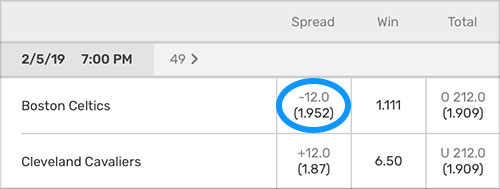Decimal Odds
Decimal Odds To American Formula
The three main betting odds formats are American, Decimal, and Fractional. In this guide you will learn how each format works and how you can convert between them. You can also use our free odds calculator to automatically convert betting odds as well as calculating the implied probability.
- Using Decimal odds, the underdog is the team with the higher of the numbers, making the favorite the team with the lower of the two numbers. Pretty straightforward! If you were to risk 100 on Nadal at odds of 1.66, you simply multiply the amount you risked (100) by the odds (1.66).
- The advantage of decimal odds Fractional odds can sometimes be confusing as the calculation can produce very large numbers. For example, where the decimal odds are 1.46, the fractional equivalent would be 23/50. In this case, it is much easier to calculate the return from a £1 stake by using the decimal odds format.
Decimal odds are widely used around Europe and are the display format of choice for the betting exchanges around the world. They are also incorporated in Asian Handicap betting which is quickly becoming a popular way of gambling on football and other events, and, to many, decimal odds are the most straightforward representation of probabilities.
It’s important to know how to convert betting odds if you want to communicate with sportsbettors across the world. People in the United States use American odds, while those in Europe use Decimal odds. Fractional odds are old school and are mainly reserved for horse-racing and long futures. While each format is used to display the same odds it can be confusing at times.
Table of Contents
American Odds
American odds (otherwise known as money line odds) are the primary format used by offshore US sportsbooks. Odds are represented by positive and negative numbers (example: -150 and +130). Here is an NFL match from 5Dimes:
A betting market with worse than even odds in the American format is displayed with a negative number. These start at -101 and get increasingly negative depending on how much that team or market is favored to win. You need to risk that amount in order to profit $100. In the example above the Carolina Panthers have -150 odds to beat the Houston Texans. This means you would need to risk $150 in order to profit $100 for a total return of $250.
A betting market with better than even odds in the American format is displayed with a positive number. These start at +101 and get increasingly positive depending on how large of an underdog the team or market is. If you were to risk $100 you would profit that amount. In the example above the Houston Texans have +130 odds to beat the Carolina Panthers. This means that if one were to risk $100 they would profit $130 for a total return of $230. A market with even odds would be represented by +100 (risking $100 nets $100 profit).
While American odds might seem uncomfortable to those already acquainted with other formats it is something that is vital to learn. A lot of great sportsbetting resources are written by American bettors and that is surely something you will want access to if you plan on becoming successful.
Convert Decimal to American
To convert decimal odds of 2.00 or higher to American you must subtract 1 and then multiply by 100:
American Odds = (Decimal Odds – 1)*100
Decimal odds of 2.35 would be (2.35 – 1)*100 = +135. While the “+” is not necessary it is considered proper notation when discussing American odds. The formula changes when dealing with decimal odds of 1.99 or lower. Now we will subtract 1 from the decimal value and use that to divide -100:
American Odds = -100 / (Decimal Odds -1)
If we had 1.91 decimal odds we would have to divide -100 by 0.91 which comes out to -110.
Convert Fractional to American
To convert fractional odds of 1/1 or higher to American odds simply multiply the fraction by 100:
American Odds = (Fractional Odds)*100
If we had fractional odds of 6/5, all we would have to do is multiply it by 100 to have it at +120. To convert fractional odds strictly lower than 1/1 use it to divide -100:
American Odds = -100/(Fractional Odds)
If we had 10/11 fractional odds we would use it to divide -100 to get American odds of -110.
Decimal Odds
Decimal odds (sometimes called European odds) are used by European betting sites. It is the easiest odds format to get use to since it directly represents the total payout from a winning bet.
If a betting market has even odds it is represented by 2.00. Markets that are worse than even will have 1.99 or lower, and markets greater than even will be 2.01 or higher. In order to calculate your payout (the total return) simply multiply your risk by the decimal odds.
Total Payout = Risk * Decimal Odds
Decimal Odds
For the game above the Chicago Cubs have 1.57 odds to defeat the Washington Nationals. If we were to bet $500 on the Cubs our return would be the product of these two values:
$500 risk * 1.57 odds = $785 Payout
It’s important to keep in mind that your payout/return includes both your initial stake and the profit you stand to make. Decimal odds are the best option for parlays/accumulators since the ticket odds will be the product of all individual wager odds.
Convert American to Decimal
If you want to convert positive American odds to decimal format you must first divide the money line odds by 100, and then add 1:
Decimal Odds = (American Odds/100) + 1
If we had a +150 underdog in the NHL we would convert it to decimal format using the above operation:
(150/100) + 1 = 2.50
Things are a bit different when we are starting with negative American odds. In this case we will use the absolute value of the money line odds to divide 100, followed by adding 1:
Decimal Odds = (100/American Odds) + 1
In order to convert a -185 American line to Decimal we would divide 100 by 185, and then add 1 to the quotient:
(100/185) + 1 = 1.54
Convert Fractional to Decimal
To convert betting odds from fractional to decimal all you need to do is convert the fraction into a decimal and then add 1:
Decimal Odds = Fractional Odds + 1

The reason we must add 1 is because while fractional odds represent the relative profit for a given risk, decimal odds represent the entire return (initial risk included). If we were to convert 3/4 into decimal we would first put the number in decimal form (0.75) and then add 1 for 1.75.
Fractional Odds
Fractional odds (otherwise called British odds) are an old-school odds format. They are used to directly represent profit relative to amount staked.
The fractional odds format represents even-odd markets as 1/1. Markets with worse than even odds would have a smaller numerator than denominator (example: 19/20). Markets with better than even odds would have a larger numerator than denominator (example: 16/5).
Fractional odds are different than decimal odds because they represent the profit and not the total return. If you risk the denominator you will profit the numerator. For example in the image above Nottingham Forest have 19/20 odds to win. If you risk $20 you would profit $19 (for a total return of $39).

Out of the three odds formats we have seen this one is the most outdated. It’s main present-day uses are for horse-racing or when discussing long odd markets such as futures and championship odds.
Convert American to Fractional
Going from American to Fractional odds formats is one of the easiest ones. To convert positive American odds to fractional simply divide the money line by 100:
Fractional Odds = American Odds / 100
For negative American odds divide 100 by the money line odds:
Decimal Odds Formula
Fractional Odds = 100 / American Odds
Convert Decimal to Fractional
To convert betting odds from decimal to fractional subtract 1 and then convert to fractional form. This is because fractional odds represent profit, and decimal odds represent total payout (including your initial risk).
Decimal Odds Table
Fractional Odds = Decimal Odds – 1
Odds Calculator
Decimal Odds To Implied Probability
If you want to quickly convert betting odds between American, Decimal, and Fractional you can use our free odds calculator. This isn’t math class so you don’t have to do the calculations on your own. But it is important to have a basic understanding of the different odds formats in order to communicate with other sportsbettors and benefit from useful sportsbetting literature.